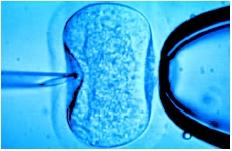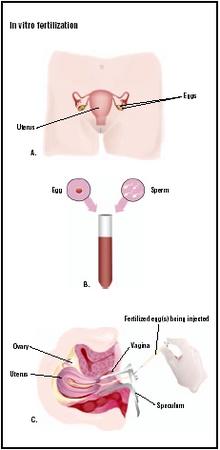In vitro fertilization
Definition
In vitro fertilization (IVF) is a procedure in which eggs (ova) from a woman's ovary are removed, they are fertilized with sperm in a laboratory procedure, and then the fertilized egg (embryo) is returned to the woman's uterus.
Purpose
IVF is one of several assisted reproductive techniques (ART) used to help infertile couples to conceive a child. If after one year of having sexual intercourse without the use of birth control a woman is unable to get pregnant, infertility is suspected. Some of the reasons for infertility are damaged or blocked fallopian tubes, hormonal imbalance, or endometriosis in the woman. In the man, low sperm count or poor quality sperm can cause infertility.
IVF is one of several possible methods to increase the chances for an infertile couple to become pregnant. Its use depends on the reason for infertility. IVF may be an option if there is a blockage in the fallopian tube or endometriosis in the woman, or low sperm count or poor quality sperm in the man. There are other possible treatments for these conditions, such as surgery for blocked tubes or endometriosis, which may be attempted before IVF.
IVF will not work for a woman who is incapable of ovulating or with a man who is not able to produce at least a few healthy sperm.
Demographics
IVF has been used successfully since 1978, when the first child to be conceived by this method was born in England. Over the past 20 years, thousands of couples have used this method of ART or similar procedures to conceive.
Description
In vitro fertilization is a procedure in which the joining of egg and sperm takes place outside of a woman's body. A woman may be given fertility drugs before this procedure so that several eggs mature in the ovaries at the same time. The mature eggs (ova) are removed from the woman's ovaries using a long, thin needle. The physician has access to the ovaries using one of two possible procedures. One involves inserting the needle through the vagina (transvaginally); the physician guides the needle to the location in the ovaries with the help of an ultrasound machine. In the other procedure, called laparoscopy , a small thin tube with a viewing lens is inserted through an incision in the navel. This allows the physician to see on a video monitor inside the uterus to locate the ovaries.
Once the eggs are removed, they are mixed with sperm in a laboratory dish or test tube. (This is the origin of the term "test tube baby.") The eggs are monitored for several days. Once there is evidence that fertilization has occurred and the cells have begun to divide, they are then returned to the woman's uterus.
In the procedure to remove eggs, a sufficient number may be gathered to be frozen and saved (either fertilized or unfertilized) for additional IVF attempts.
Diagnosis/Preparation
Once a woman is determined to be a good candidate for in vitro fertilization, she will generally be given fertility drugs to stimulate ovulation and the development of multiple eggs. These drugs may include gonadotropin-releasing

The screening procedures and treatments for infertility can become a long, expensive, and, sometimes, disappointing process. Each IVF attempt takes at least an entire menstrual cycle and can cost $5,000–10,000, which may or may not be covered by health insurance. The anxiety of dealing with infertility can challenge both individuals and their relationship. The added stress and expense of multiple clinic visits, testing, treatments, and surgical procedures can become overwhelming. Couples may want to receive counseling and support through the process.
Aftercare
After the IVF procedure is performed, the woman can resume normal activities. A pregnancy test can be done approximately 12–14 days after the procedure to determine if it was successful.
Risks
The risks associated with in vitro fertilization include the possibility of multiple pregnancy (since several embryos may be implanted) and ectopic pregnancy (an embryo that implants in the fallopian tube or in the abdominal cavity outside the uterus). There is a slight risk of ovarian rupture, bleeding, infections, and complications of anesthesia. If the procedure is successful and pregnancy

Normal results
Success rates vary widely among clinics and among physicians performing the procedure. A couple has about a 10% chance of becoming pregnant each time the procedure is performed. Therefore, the procedure may have to be repeated more than once to achieve pregnancy.
Abnormal results include ectopic or multiple pregnancy that may abort spontaneously or that may require termination if the health of the mother is at risk.
Morbidity and mortality rates
The most common cause of morbidity is ecotopic pregnancy. Pain is associated with most components of the procedure. Mortality as a result of IVF is extremely rare.
Alternatives
Other types of assisted reproductive technologies might be used to achieve pregnancy. A procedure called intracytoplasmic sperm injection (ICSI) utilizes a manipulation technique that must be performed using a microscope to inject a single sperm into each egg. The fertilized eggs can then be returned to the uterus, as in IVF. In gamete intrafallopian tube transfer (GIFT), the eggs and sperm are mixed in a narrow tube, and then deposited in the fallopian tube, where fertilization normally takes place. Another variation on IVF is zygote intrafallopian tube transfer (ZIFT). As in IVF, the fertilization of the eggs occurs in a laboratory dish. And, similar to GIFT, the embryos are placed in the fallopian tube, rather than in the uterus as with IVF.
Resources
books
Boggs, William M., and Rosella D. Smith. The Journey to Fertility: A Couple's Guide to In Vitro Fertilization. Timonium, MD: Wilrose Books, 2001.
DeJonge, Christopher J. Assisted Reproductive Technologies: Current Accomplishments and New Horizons. Oxford: Cambridge University Press, 2002.
Elder, Kay, and Brian Dale. In Vitro Fertilization, 2nd edition. Oxford: Cambridge University Press, 2000.
Trounson, Alan O., and David K. Gaardner. Handbook of In Vitro Fertilization, 2nd edition. Boca Raton, FL: CRC Press, 1999.
periodicals
Aboulghar, M. A., R. T. Mansour, G. I. Serour, H. G. Al-Inany, and M. M. Aboulghar. "The Outcome of In Vitro Fertilization in Advanced Endometriosis with Previous Surgery: A Case-controlled Study." American Journal of Obstetrics and Gynecology 188, no. 2 (2003): 371–375.
Kolibianakis, E. M., et al. "Outcome for Donors and Recipients in Two Egg-sharing Policies." Fertility and Sterility 79, no. 1 (2003): 69–73.
Puskar, J. M. "Prenatal Adoption: The Vatican's Proposal to the In Vitro Fertilization Disposition Dilemma." New York University Law School Journal of Human Rights 14, no. 3 (1998): 757–793.
Squires, J., A. Carter, and P. Kaplan. "Developmental Monitoring of Children Conceived by Intracytoplasmic Sperm Injection and In Vitro Fertilization." Fertility and Sterility 79, no. 2 (2003): 453–454.
organizations
American Board of Obstetrics and Gynecology. 2915 Vine Street, Suite 300, Dallas, TX 75204. (214) 871-1619; Fax: (214) 871-1943. info@abog.org. http://www.abog.org .
American College of Obstetricians and Gynecologists. 409 12th St., SW, P.O. Box 96920, Washington, DC 20090-6920. http://www.acog.org .
American Infertility Association. 666 Fifth Avenue, Suite 278, New York, NY 10103. (718) 621-5083. E-mail: <info@ americaninfertility.org. http://www.americaninfertility.org .
American Society for Reproductive Medicine. 1209 Montgomery Highway, Birmingham, AL 35216-2809. (205) 978-5000. http://www.asrm.com .
International Council on Infertility Information Dissemination, Inc. P.O. Box 6836, Arlington, VA 22206. (703) 379-9178. http://www.inciid.org .
other
American Society for Reproductive Medicine. [cited March 1, 2003]. http://www.asrm.org/Patients/FactSheets/invitro.html .
Columbia University College of Physicians and Surgeons. [cited March 2, 2003]. http://www.columbia.edu/cu/news/01/09/in_vitro_prayer.html .
Encyclopedia.Com. [cited March 2, 2003]. http://www.encyclopedia.com/html/i1/invitro.asp .
International Council on Infertility Information Dissemination. http://www.inciid.org/ivf.html .
L. Fleming Fallon Jr., MD, DrPH
WHO PERFORMS THE PROCEDURE AND WHERE IS IT PERFORMED?
An obstetrician-gynecologist (OB-GYN) with specialized training in IVF supervises the activities of IVF. This specialist performs most of the procedures involving the woman. Most IVF activities are performed in a professional medical office.
The writer as written only for we the professionals to understand, but the laymen may want to take up option of IVF if they have a clear understanding of the procedure and the success rate.
Thanks
Dr O. 'Lanre OLAITAN, Ph.D.